Graphic Designer [email protected] mattwrightdesign.co.uk (coming soon)
Don't wanna be here? Send us removal request.
Text
Little influences - An Example
As I'm very aware I can't just tell people what to do and how to make a difference i will be taking a slightly different approach, I will be applying the nudge theory, attempting to make change in this manner, and exmaple of this is simply -
Yawning is incredibly contagious. I made some of you reading this yawn simply by writing the word "yawn." The people who yawned when they saw you yawn, mean- while, were infected by the sight of you yawning — which is a second kind of contagion. They might even have yawned if they only heard you yawn, because yawning is also aurally contagious: if you play an audiotape of a yawn to blind people, they'll yawn too. And finally, if you yawned as you read this, did the thought cross your mind — however unconsciously and fleetingly — that you might be tired? I suspect that for some of you it did, which means that yawns can also be emotionally contagious. Simply by writing the word, I can plant a feeling in your mind. Can the flu virus do that? Contagiousness, in other words, is an unexpected property of all kinds of things, and we have to remember that, if we are to recognize and diagnose epidemic change.
0 notes
Text
Nudge Theory
Nudge theory (or Nudge) is a concept in behavioral science, political theory and economics which argues that positive reinforcement and indirect suggestions to try to achieve non-forced compliance can influence the motives, incentives and decision making of groups and individuals alike, at least as effectively – if not more effectively - than direct instruction, legislation, or enforcement.
At the heart of nudge theory is the concept of nudge. This was originally defined by Richard Thaler and Cass Sunstein as follows:
“A nudge, as we will use the term, is any aspect of the choice architecture that alters people’s behavior in a predictable way without forbidding any options or significantly changing their economic incentives. To count as a mere nudge, the intervention must be easy and cheap to avoid. Nudges are not mandates. Putting fruit at eye level counts as a nudge. Banning junk food does not.”
Notability -
“Nudge,” as it is often referred, is usually credited to Richard Thaler a prominent professor of Behavioural Science and Economics at the University of Chicago Booth School of Business. Thaler's role in developing the “Nudge Theory” is usually discussed in parallel with Daniel Kahneman, an American psychologist.
Nudge Theory rose to global prominence in 2008 with the release of the book Nudge: Improving Decisions About Health, Wealth, and Happiness, by Thaler and legal scholar Cass R. Sunstein. The volume not only brought the discourse on Nudge theory to the wider public, but secured a significant following among contemporary US and UK political personalities as well as the private sector involved with public health and related fields. Nudge theory and similar policy frameworks have been criticized by some psychologists for failing to take into account the psychological determinants of the behaviors that they are trying to change.
Most recently, the political machinery of both President Barack Obama in the United States and Prime Minister David Cameron in the UK have sought to employ Nudge Theory to advance their respective domestic policy goals. In the UK there is a Behavioural Insights Team in the UK government.
1 note
·
View note
Photo
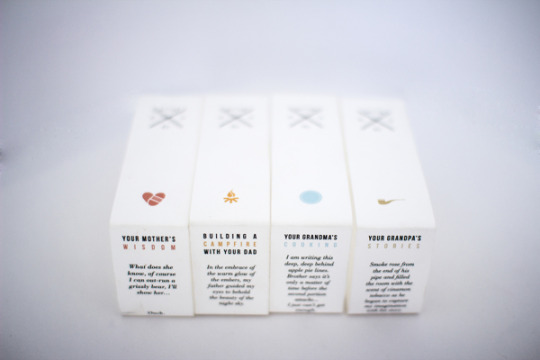

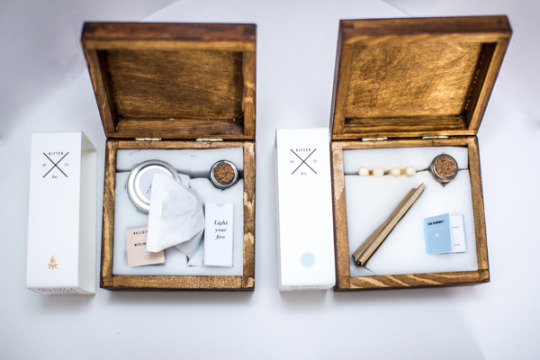
Branding the Unbrandable - Experiences
These boxes were designed to brand experiences, each box contains a story explaining the experience, a sense of smell to evoke nostalgia, something to enable you to feel the experience and something to enable you to perform the experience.
I am looking in to a possible box of cards and using a small booklet as some supporting material for my project and these boxes really caught my eye, they are a little off topic but i just though i would share as i really liked the small sleeve and the whole idea, branding the unbrandable... nice.
1 note
·
View note
Photo




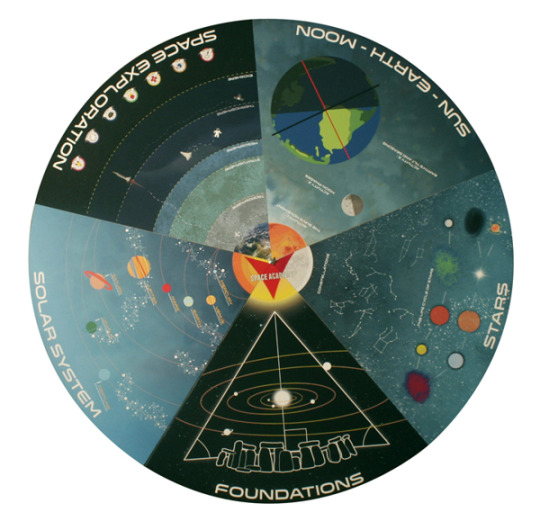
This is a teacher kit for a middle school grade science class learning about space. I created the kit for the solar system lesson. It includes 3 activities and a lesson plan guide for the teacher.
I'm just looking in to other kits and guides that exist for possible outcomes and ideas. I'm looking at kits that cover a whole subject rather well, this one covers a subject and a class, mine will cover something a bit larger but its a good starting point.
1 note
·
View note
Photo


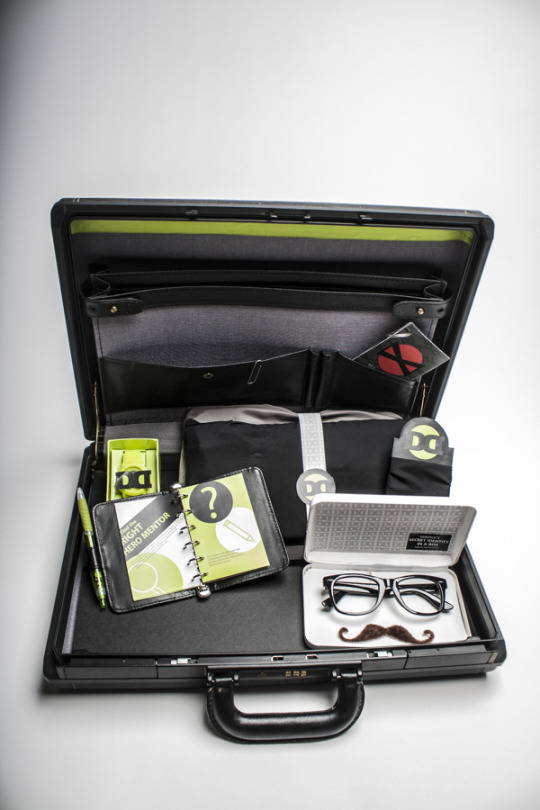
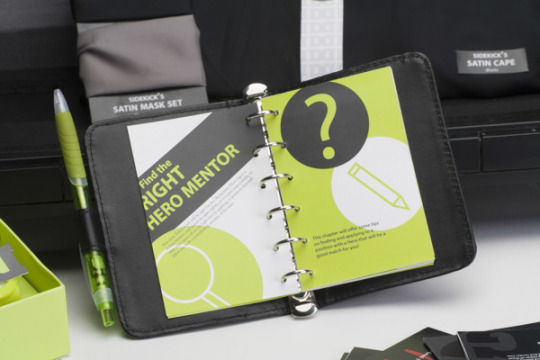
Dynaic Duo - A Guide to Being a Perfect Sidekick.
This kit, featuring a manual, specialty watch, set of capes , eyemasks ,SuperVillain flashcards and custom briefcase should provide any aspiring sidekick with all they need to make it in the competitive world of Super Heroes.
I'm considering taking my project in the direction of a field guide, or some kind of basic instruction to making a difference, up on doing research it appears a lot of people would like to get involved but have no idea how to or need inspiration.
0 notes
Text
Bristol Pound
http://bristolpound.org/
The Bristol Pound is the UK’s first city wide local currency, the first to have electronic accounts managed by a regulated financial institution, and the first that can be used to pay some local taxes.
The Bristol Pound is run as a partnership between the Bristol Pound Community Interest Company and Bristol Credit Union. It is a not-for-profit social enterprise.
I'm looking into different levels of kindness and well-being that people do, and there was a great community benefit - the bristol pound, i feel that this is a great way to raise community spirit and it makes you feel good even spending this currency.
0 notes
Text
Real Superheroes ... ?
If you’re anything like anybody, you’re in love with the idea of superheroes. The rest of you are boring. In either case, all of us have an innate urge deep inside that makes us want to do good for the people around us, and while some of us are content to read about the super powered good deeds of others, the people on this list decided to stand up and show the world that crime does not pay. Unfortunately, they chose a route that looks absolutely, thoroughly ridiculous. Here are 5 real life superheroes who could be behind you right now.
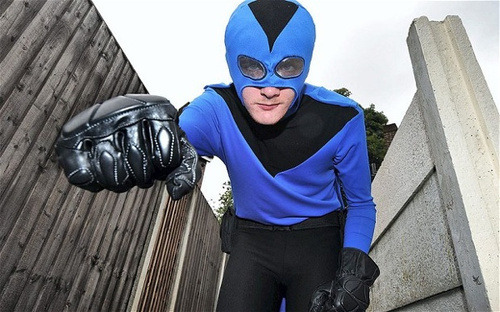
Secret Identity: Roger Hayhurst
Personal Gotham: Salford, Greater Manchester, UK
Gardener by day, masked crime fighter by night—that’s the tagline for Knight Warrior, a 19 year old in the UK whose self-proclaimed superpower is a “supernatural desire to make the world a better place.” His main target is drunk people who get a little too rowdy as they leave pubs. When there aren’t enough people fighting each other, he hands out food to homeless people in the Greater Manchester area.
Although he doesn’t have any combat training, gadgets, weapons, or identifiable means of protection, he does have a flashy costume, and sometimes that’s exactly what you need to get people’s attention. According to him, “When people see me coming up it does tend to stun them intosilence.” Knight Warrior lives with his mother.
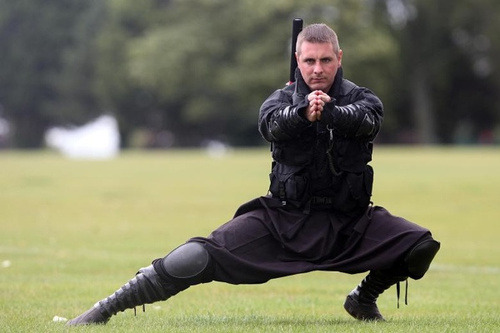
Secret Identity: Ken Andre
Personal Gotham: Yeovil, Somerset, UK
Eschewing the pomp and flash of a typical superhero costume, 33 year old Ken Andre took a different approach to vigilante justice: the way of the ninja. He calls himself Shadow and spends up to four nights a week out around his home in Somerset stopping drug dealers and muggers—in the few years he’s been doing this, he says he’s stopped several dozen crimes. And out of all the people on this list, Shadow is the only real life superhero with anything even resembling a super power—a Batman-esque hearing aid that amplifies sound.
Ken has been studying the martial art Ninjutsu since he was a child, and stopped a carjacker one time by literally throwing nunchucks at him. In his own words, “I tied him to the lamppost using his own legs and called the police.”
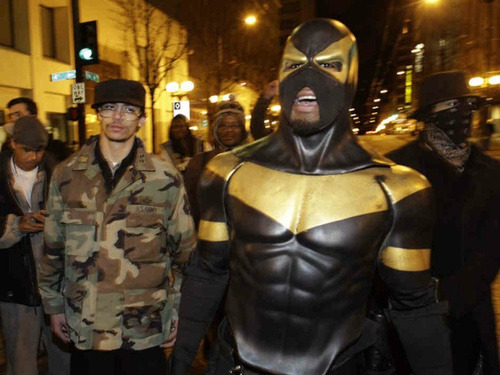
Real Name: Benjamin Fodor
City: Seattle, Washington
Of all these real life superheroes, Phoenix Jones has probably received the most media attention, especially after being arrested in 2011 for pepper spraying two women. He patrols the area around Seattle and claims that he was motivated to don a mask and cape after his car was broken into and none of the bystanders tried to stop it from happening. Knife wounds,gunshots, street fights—it’s all in a day’s work for Phoenix Jones. The 22-year old is also a professional MMA fighter, which probably comes in handy as he tracks down criminals.
Also unlike a lot of other people who pretend to be superheroes, Phoenix’s costume actually has a bullet proof vest and armour plating.
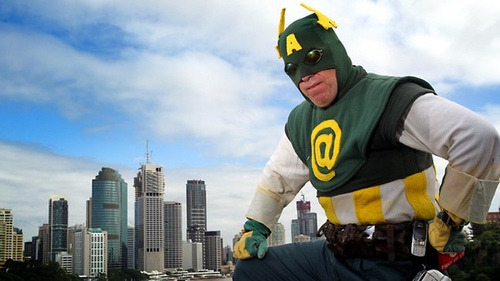
Secret Identity: Secret!
Personal Gotham: Brisbane, Australia
With gardening gloves flexed and ampersat blazing, Captain Australia is waging a one-man war against crime in Fortitude Valley. In his day life he’s a stay-at-home father of two, but a desire to clean up Queensland’s streets has motivated him to put together a makeshift costume and patrol some of the “seedier areas” of Brisbane at night.
Captain Australia takes a preventative approach to crime, figuring that the sight of him will be enough to deter most would-be criminals from acting on their insatiable dark urges. And sometimes it works—he claims to have stopped a rape by showing up on the scene and scaring away two men who had been harassing a drunk woman.
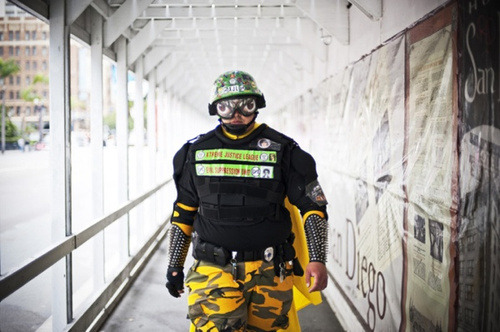
Secret Identity: Secret!
Personal Gotham: San Diego, California
Honestly, if there’s any city that needs a superhero it’s probably San Diego, especially after the police department was downsized in 2012, leading to anincrease in crime. And Mr. Extreme might not be the hero San Diego deserves, but he’s the hero San Diego puts up with. A security guard in the daylight hours, once the sun goes down he suits up with shin guards, cape, army helmet and identity-protection goggles, then vigorously strolls into the crime-ridden sidewalks of the East Village.
Mr. Extreme has been working for about seven years now, armed with a taser, handcuffs, three cans of pepper spray, and the conviction that right is always the right thing to do. While he doesn’t get into a whole lot of action, he has instigated several citizens arrests throughout his career.
0 notes
Text
UK Riot Vigilantes Attempt To 'Reclaim The Streets' - a look into vigilante justice
After consecutive nights of rioting in London, large groups of vigilantes were seen patrolling the London boroughs of Enfield, Eltham and Southall on Tuesday night.
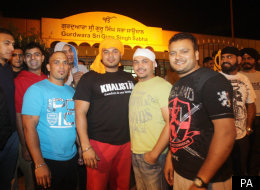
Though such groups have been condemned by the police as counter-productive, it seems that these residents felt the police had already failed the test of protecting them from looters, vandals and rioters. Despite a huge increase in the numbers of police on the streets last night, they had decided to take matters into their own hands.
As many as 200 men were seen roaming the streets in Enfield and Eltham. Members of the English Defence League, the far right group, were said to be heavily involved. The English Defence League claims around half of the Enfield vigilantes were its members. Stephen Lennon, leader of the group, said: 'We're going to stop the riots - police obviously can't handle it.' Many of the other men were said to be Millwall fans. The football club plays in nearby Lewisham, which was the scene of violent disorder earlier this week.
In Southall, West London, local men turned out to guard a Sikh temple. Some were armed with swords, others were carrying hockey sticks. More then 700 men, some in their 80s, took to the streets to protect their homes and businesses, after almost 100 rioters had tried to attack the area earlier on Tuesday. With few police around, elders at London's largest Sikh temple in Havelock Road resorted to telephoning male worshippers for help.
The police have roundly condemned the role of such community groups. Deputy Assistant Commissioner Steve Kavanagh, from the Metropolitan Police said: "What I don't need is these so-called vigilantes, who appeared to have been drinking too much and taking policing resources away from what they should have been doing - which is preventing the looting."
Others have seen this street patrolling as an excuse for the EDL to capitalise on disorder and as an unwelcome distraction from the attempt to calm the tense atmosphere in these London boroughs. However, Patrick Hayes who was reporting for Spiked Online, joined an anti-riot vigilante group in Enfield on Tuesday night and was quick to defend them:
'It is testament to today's snooty view of white working-class communities that many assume that any gathering of a few hundred white blokes must be a racist pogrom-in-the-making. Used to consensual rather than conflictual policing, even large numbers of officers on the streets have proved ineffectual when it comes to preventing or offsetting nihilistic behaviour'.
One of the vigilante patrollers, Nick Davison, summed up the mood of many when he told Sky News:
'We've had enough of the police just standing there, basically scratching their arses while people are looting and ruining the whole area. Everybody here pays tax and we've all had enough of it. We're sickened by the police doing absolutely nothing.
0 notes
Text
Hero shopkeeper fights off armed raider with broom - Real Crime Fighting
A SHOPKEEPER has spoken of his terror after being held-up at knifepoint by an alcohol-fuelled masked robber.
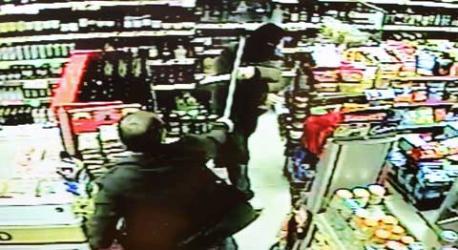
Despite fearing for his life, Mehmet Ekinci foiled late-night raider Stephen Sherwood after beating him with a broom and forcing him to the floor.
With the help of his assistant Medet Coban and a plucky member of the public Sherwood was disarmed and restrained until police officers arrived at the Premier store on Holdenhurst Road, Bournemouth.
Mr Ekinci, 41, suffered sleepless nights and was too traumatised to work in the family business for more than a month.
But on the day Sherwood, 18, was jailed for two years and three months he finally returned for a morning shift.
He told the Daily Echo: “I’m still too frightened to work alone or at night.
“The memories keep flooding back and I am scared that another customer will pull a knife on me again. The sentence isn’t long enough; he will be out in just over a year.
“At first I thought he was joking but when he started waving the blade towards me I realised he was deadly serious.
“I called on Medet to get a brush and used the broom handle to tackle him.
“We managed to get him to the floor and a customer who was coming into the shop kicked the knife away.”
Mr Ekinci’s son Salman, 20, who had to take time off from his studies in London to help out in the shop, said: “It could all have gone horribly wrong – anything could have happened.”
Sherwood of Malmesbury Park Road admitted robbery and possessing an offensive weapon last month.
Prosecutor Jennie Rickman said Mr Ekinci had been stock-taking behind the counter when he heard Sherwood’s demands for money.
The drunk teenager was wearing a balaclava and brandishing a kitchen knife with a 30cm blade when he leaned across the counter for cigarettes, pointing the blade at Mr Ekinci who used his clipboard to defend himself.
Mrs Rickman told Bournemouth Crown Court how Sherwood was left unconscious and how there was blood on the floor following the scuffle.
The entire incident was caught on the shop’s CCTV cameras.
Following his arrest Sherwood told police he had drunk two litres of port and couldn’t remember carrying out the raid.
In his defence the court heard that the offence had been “a cry for help” and Sherwood was sorry for the anguish he had caused.
His mental health was described as “fragile.”
Judge Peter Johnson told him: “This was a clumsy, drunken robbery.
“You waved a large kitchen knife, no doubt inducing terror in two people going about their lawful business and providing a useful service, for a few packets of cigarettes.
“No-one knows what might have happened; it was an extremely dangerous act.”
0 notes
Text
3 Vigilantes Donning a Costume
Angle-Grinder Man
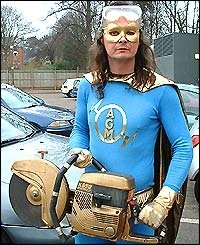
Angle-Grinder man may not the most exciting of super hero alter egos, and certainly not the coolest based on some of the examples here, but at least he does what he says on the tin. This blue leotard clad middle aged man became rather popular among motorists in London and Kent in 2003 when he started offering a free wheel clamp removal service to anyone who was in need. Angle-Grinder Man was perhaps not the most traditional of superheros but he certainly was popular and fitted in a niche that for motorists at least, needed to be filled.
Mr. Exreme
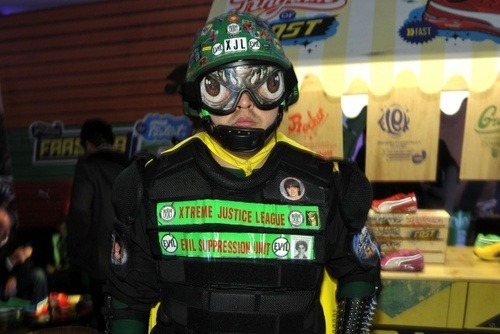
Mr. Xtreme and his fellow superheroes in the Xtreme Justice League (a group founded by Mr. Xtreme) are committed to fighting crime in the city of San Diego and surrounding area.
Mr. Xtreme, identity unknown, works as a security guard during the day. Motivated by his own personal history as a survivor of violent crime, Mr. Xtreme takes to the streets every night, protecting and empowering citizens and intervening as needed.
Each superhero in the Justice League has their own individual style, and Mr. Xtreme's costume is an eclectic mix, including body armor and pinhole goggles -- in total he carries 30 to 40 pounds of gear with him.
Phoenix Jones
Phoenix Jones, along with other superheroes in the Rain City Superhero Movement, fights crime -- and calls 911 a lot -- on the streets of Seattle. This Seattle super squad, a group of crime fighters whose members include characters such as Green Reaper, No Name, and Catastrophe, patrol every night, and among them carry batons, pepper spray and tasers -- plus cell phones. Jones looks like a comic-book superhero, costumed in molded, Batman-style body armor, including a ballistic vest, a ballistic cup, and arm and leg trauma plates. Like his fellow superhero crime fighters, he hides his identity behind a mask; Jones' is black and gold. His true identity, revealed after the superhero was arrested in 2011, is Benjamin John Francis Fodor, a special education teacher and father of two.
0 notes
Text
3 Real-Life Vigilantes gone bad
#1. Jonathan "Jack" Idema

Idema and his associates Brent Bennett and Edward Caraballo were arrested on July 5, 2004 by Afghan police during a raid in which they found eight Afghan men (some hanging from their feet) bound and hooded in detention. The arrest of Idema occurred only about three months after 60 minutes II broke the story about the torture and abuse scandal.
Idema claimed to have had private contact with Lieutenant General Boykin and several other senior Pentagon officials. Regarding Boykin, Idema somehow obtained the phone number for Boykins office in the Pentagon and started making unsolicited calls from Afghanistan via his SatPhone. He was looking to establish a relationship with Boykin's office (or anyone else) to obtain funding for his efforts. The executive assistants answering Boykins phone couldnt stop Idema's constant and unwanted calls, emails, and faxes. Other senior officials in Boykins office ultimately intervened, and Idema was asked on multiple occasions to "cease and desist" with his unsolicited calls. Idema ignored these requests and continued making random phone calls to Boykins front office until his arrest. Idema subsequently stated that he had a relationship with Boykins office. The only relationship that ever existed had to do with personnel in Boykins office politely trying to get Idema to stop his unwanted phone calls, emails, and faxes.
He tried further to prove his official status when he claimed to be working for the US Counter Terrorism group, the same group that some sources say he founded
#2. The Lavender Panthers
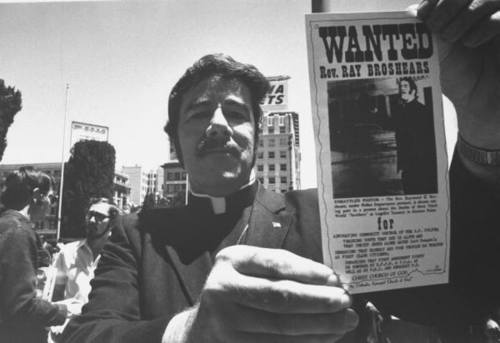
Four San Francisco teen-agers recently got the surprise of their young lives. Tooling around in their souped-up car looking for a little fun, they spotted two homosexuals leaving the Naked Grape, a well-known gay bar. The youths roared to a stop, jumped out of their car and began to push the homosexuals around. Suddenly a brawny band, led by a man in a clerical collar, leaped from a gray Volkswagen bus and lit into them. "We didn't even ask questions," said the Rev. Ray Broshears, 38. "We just took out our pool cues and started flailing ass." The teen-agers fled into the night, only to return ten minutes later, begging for their car: "Look, man, we don't want no trouble."
The group they most assuredly did not want trouble with was the Lavender Panthers, a stiff-wristed team of gay vigilantes who have taken to the streets of San Francisco to protect their confreres against just such attacks. Formed by the Rev. Ray, a Pentecostal Evangelist and known homosexual who himself was once beaten severely outside his gay mission center, the Panthers patrol the streets nightly with chains, billy clubs, whistles and cans of red spray paint (a substitute for forbidden Mace). Their purpose, as the Rev. Ray candidly puts it, is to strike terror in the hearts of "all those young punks.
Beyond their stipulation against the Panthers' carrying guns, the police have not interfered with the patrols, nor have they received any complaints from anyone the Panthers have accosted. Indeed, the Panthers have gotten more heat from their own brethren than from the police. Bill McWilliams, owner of three gay bars, says, for example, that the patrons of his Boot Camp bar can take good care of themselves. Moreover, many of the city's affluent gays do not like the idea of hard-eyed homosexual toughs causing commotion in the streets.
#3. The Bald Knobbers
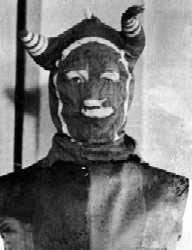
The Bald Knobbers were a group of vigilantes in the southern part of the state of Missouri during the period 1883–1889. They are commonly depicted wearing hoods with horns, a distinction that evolved during the rapid proliferation of the group into neighbouring counties from its County Origins.
The group got its name from the grassy bald knob summits of the Ozark Mountains in the area. The hill where they first met is called Snapp's Bald, located just north of Kirbyville, Missouri.
The Bald Knobbers, who for the most part had sided with the North in the American Civil War, were opposed by the Anti-Bald Knobbers, who for the most part had sided with the Confederates. They Swiftly killed any person who opposed them in the name of justice, no questions asked.
0 notes
Text
Channel 4 Documentary - Superheroes of Suburbia
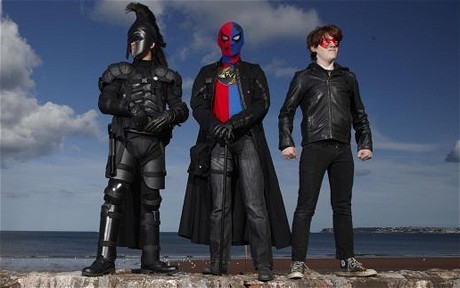
My project has had a bit of a slow start, getting an idea off of the ground has been difficult, i have looked in to everything from sci-fi to batman, and then it finally came to me, what does batman stand for?
He is a caped crusader, a vigilante, and that got me thinking, are there any real life vigilantes? Turns out there are loads of real life day to day heroes, from burglar-fending brush wielding shop keepers to local people donning a costume and fighting crime. It turns out channel 4 have covered this subject a bit so i decided to watch the documentary.
We saw Will, the first profile, eating his cornflakes with wife and baby in full regalia looking, essentially, like a total numpty. “Have I got gravy down my chin?” asked his wife. Hardly something you’d hear Lois Lane saying.
“If I could get inside and stop some massive crime boss or drug syndicate in Torbay that would be great,” explained Will. Instead we saw him making sure cabbaged revellers got home safe from outside the local KFC – or trying to. “You’re full of b------t and dressed like an ass,” said one man on the street. He was not wrong.
Next up was Kieran, a 17-year-old comic book obsessive from the North East. His superhero name is Noir. His mate Barry "thinks he would be really good” but his Mum didn't seem too happy: “He needs to learn about the world,” she said.
Then we had Ken (The Shadow) bringing the ancient Japanese art of ninja to Somerset. He did his war roar and you couldn’t really help but cringe. We also heard how he “head-butted someone to the ground” while on “patrol” which opened up a whole other ethical can of worms.
0 notes
Photo




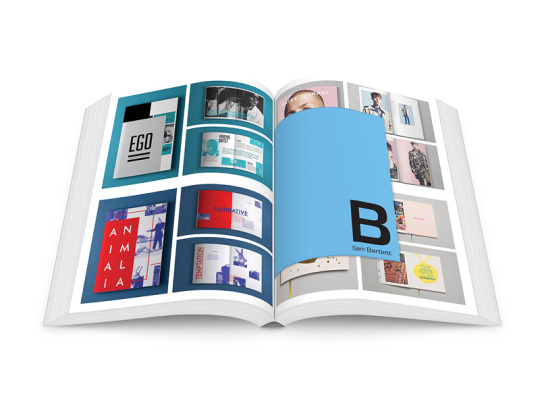
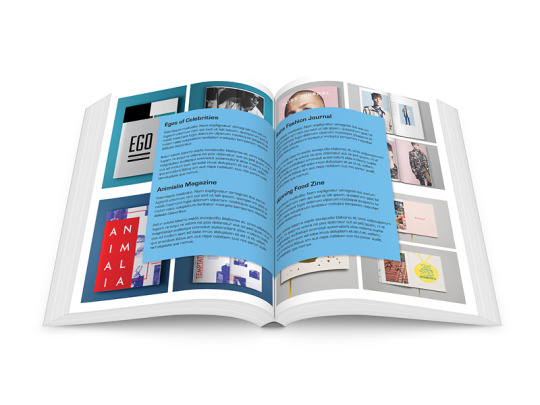
End of Year Show Proposal - Chroma:
A recent project had me teaming up with designers Matt Wright and Oliver Purssey. Our brief was to create an identity for our BA Visual Communication end of year show; initially we considered Jigsaw with the thought that everyone was a piece in a larger picture. However, as we presented we found that people thought that the idea was too obvious, and the puzzle imagery wasn’t as strong as we had first thought.
Over the past few weeks, we developed a new identity with a similar premise. Visual Communication is a combination of Graphic Design and Illustration, and all the students lie somewhere within that spectrum. Chroma (coming from the word Chromatic, ‘produced by colour’) encompassed this idea, every student was represented by their own shade of colour, which was part of a bigger spectrum. The Chroma pattern consists of 5 different colours, and could be altered for each student and/or their work.
The pamphlets would be free for every visitor on the day, and could be printed in a series of colours (unassigned to students). Catalogues could be purchasable on the day (this would help fundraise and pay for the printing costs) and would hold every students work. Every student would get a double page spread that would hold roughly 12 images and 3 pieces of their work; in the middle of these pages would be a smaller double page spread that would hold information on their projects and their personal details - should a visitor or potential employer wish to contact them at a later date.
4 notes
·
View notes
Photo



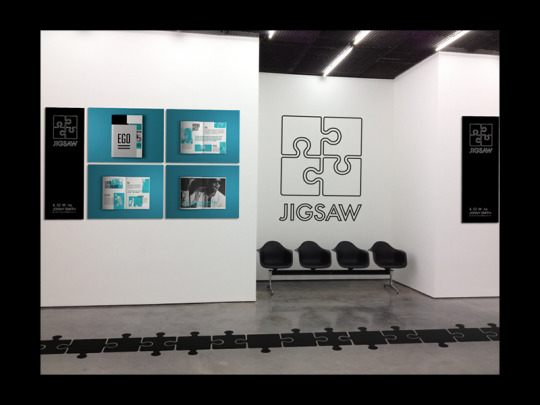

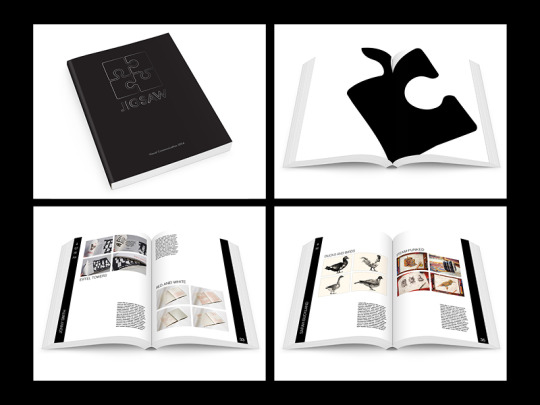

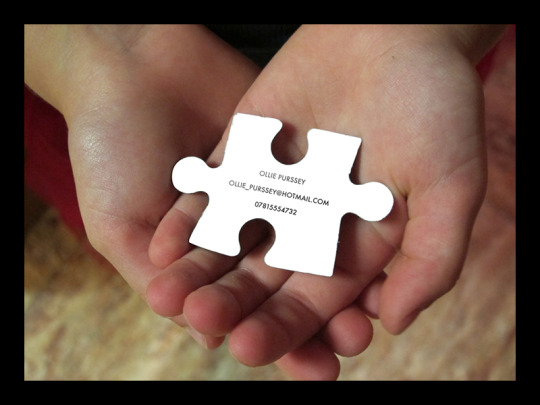
End of Year Show Proposal - Jigsaw:
A recent project had me teaming up with designers Matt Wright and Oliver Purssey. Our brief was to create an identity for our BA Visual Communication end of year show, after cycling through many ideas we settled on the idea of ‘Jigsaw’. Everyone in our year group was their own unique piece that made up part of the bigger picture of the course, without them the bigger picture would be incomplete - this was our thinking behind the name and identity.
We experimented with many different ideas when creating the Jigsaw logo, firstly we thought about the CMYK colours of print, but thought that it was too obvious and cliché. In the end we gravitated towards just the lines for the logo because if it was to be shown alongside student’s work we didn’t want it to take any prominence (like the block colour logos would have).
Accompanying the logo would be four (or more) icons, these would be determined by the skills and traits of the students, for example I would choose Editorial Design and Illustration. This would help viewers and potential employers on the day easily navigate through the students that would be most relevant to them - for example someone looking for an illustrator wouldn’t go through the typography students, however if this system was not in place they would be forced to.
A catalogue of work would be available to purchase on the day (for perhaps £2-5) which would help subsidise printing costs. There would also be a free brochure with a broader scope of the exhibition available if viewers did not want to buy the catalogue but still wanted a memento of the day.
Finally, we thought that everyone next to their stand in the exhibition could have a jigsaw that was made up of their work. Each piece would serve as a business card, as the student’s details would be available on the back. At the end of the day you can track your progress easily by seeing how much of your puzzle has been taken by potential employers.
1 note
·
View note
Photo







Eat Me: Appetite For Design.
Food has long been a source of inspiration to cultures around the world. The passionate designers at the forefront of the field have poured their creativity into every aspect of food culture. Eat Me gathers an extraordinary collection of designed places, art products, brands, people, and commodities within the world of food. New trends and materials have led to unique opportunities for the designers of today to enhance and elevate one’s culinary experience by speaking to our minds as well as our stomachs. Eat Me features not only the best in food packaging but also side products like utensils, kitchenware, and menu design. Eating spaces are also included in a special section of the book that gives a round-the-world tour of the latest and most innovative cafes, bars, and restaurants. The third section of the book is about the arts and showcases the latest events, exhibitions, installations, and art pieces made with or inspired by food. Explore the latest trends through numerous up to the minute case studies, each distinct with regards to product, materials, aesthetic, and consumer experience.
Buy it here:
USA: http://amzn.to/1eIMZUC UK: http://amzn.to/1bmXK8E
1K notes
·
View notes
Link
Lynn Sisco is using Pinterest, an online pinboard to collect and share what inspires you.
This was a really useful link in the planning of my flip book, it shows me that it doesnt need to be a conventional layout.
0 notes